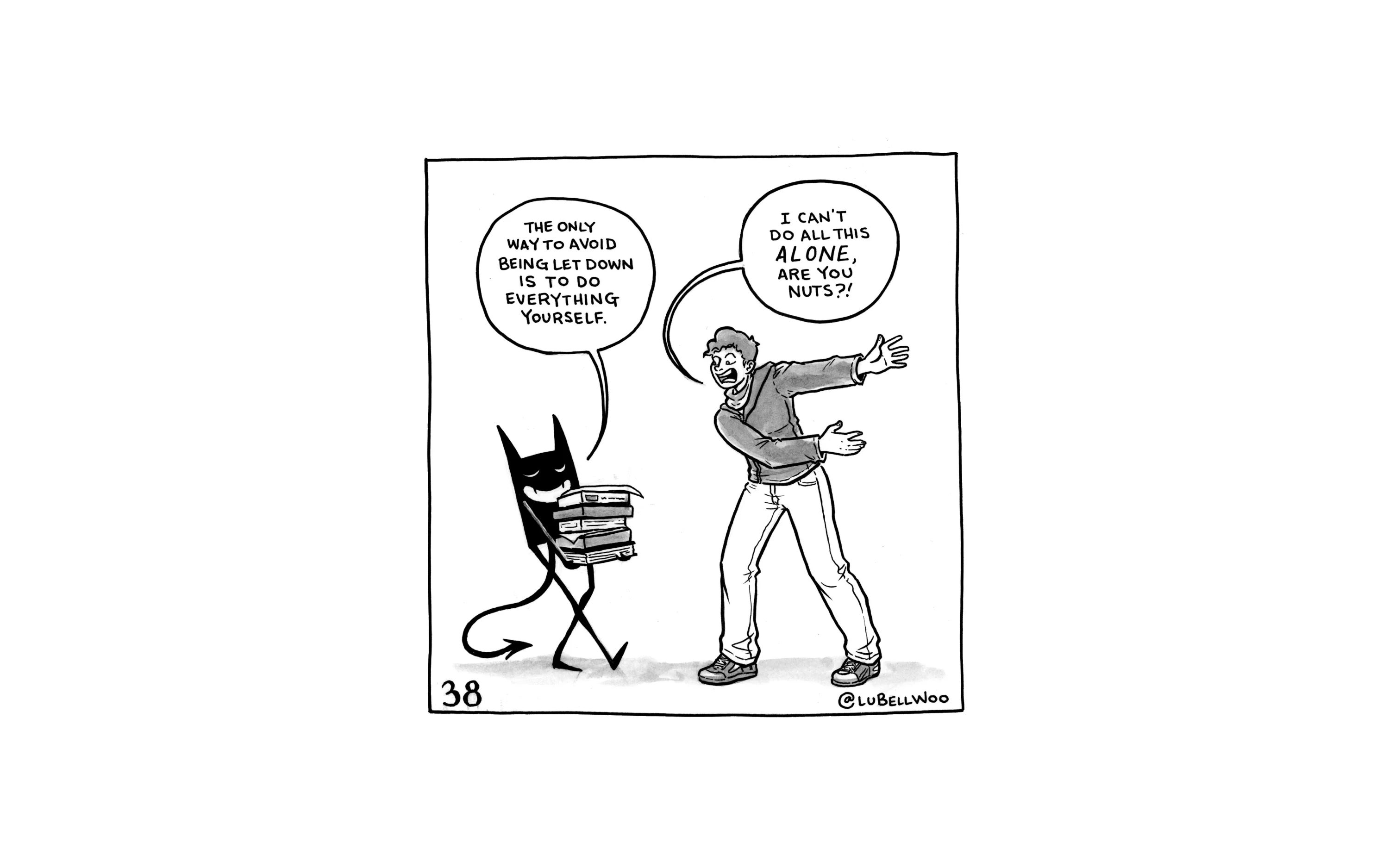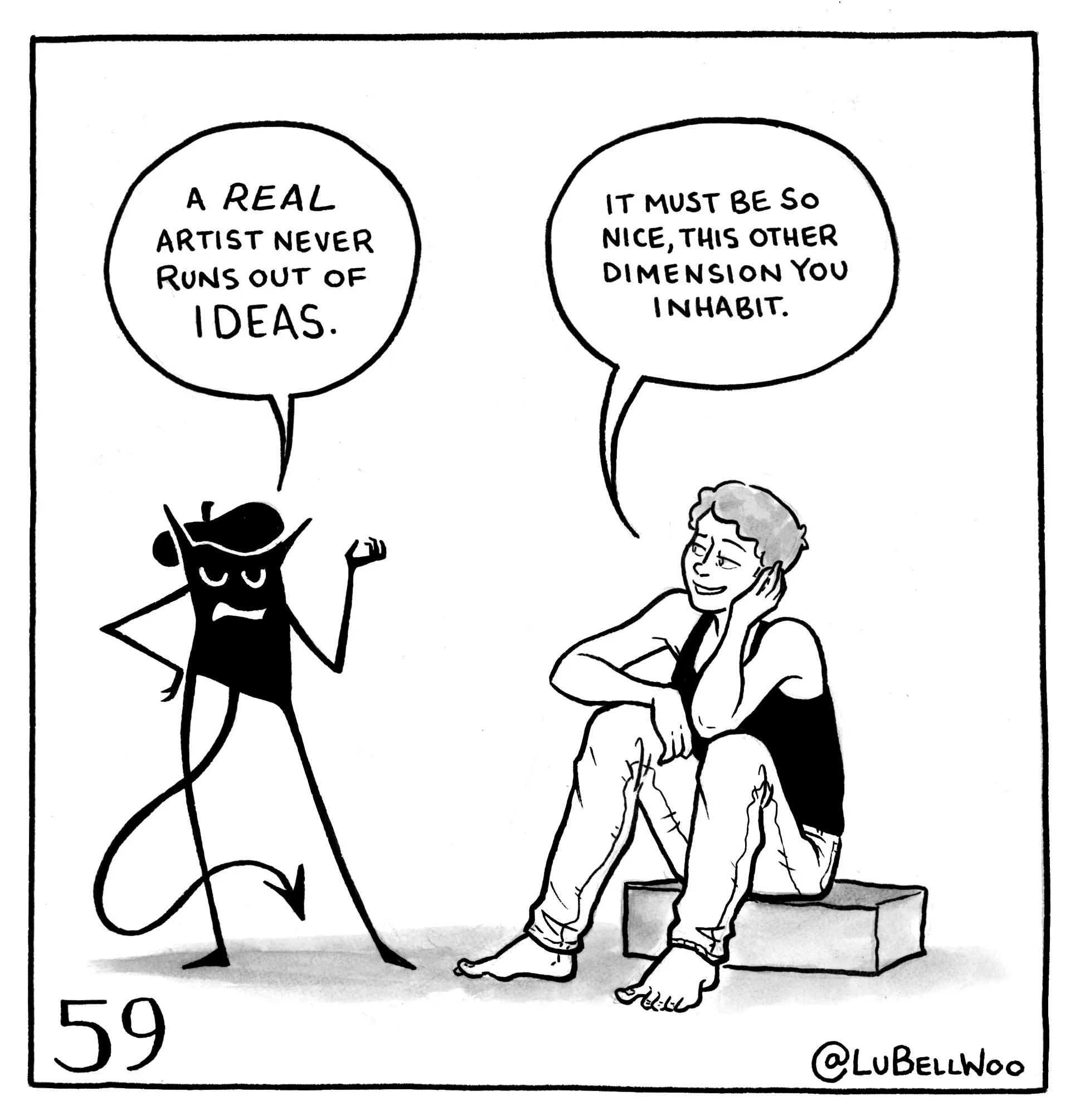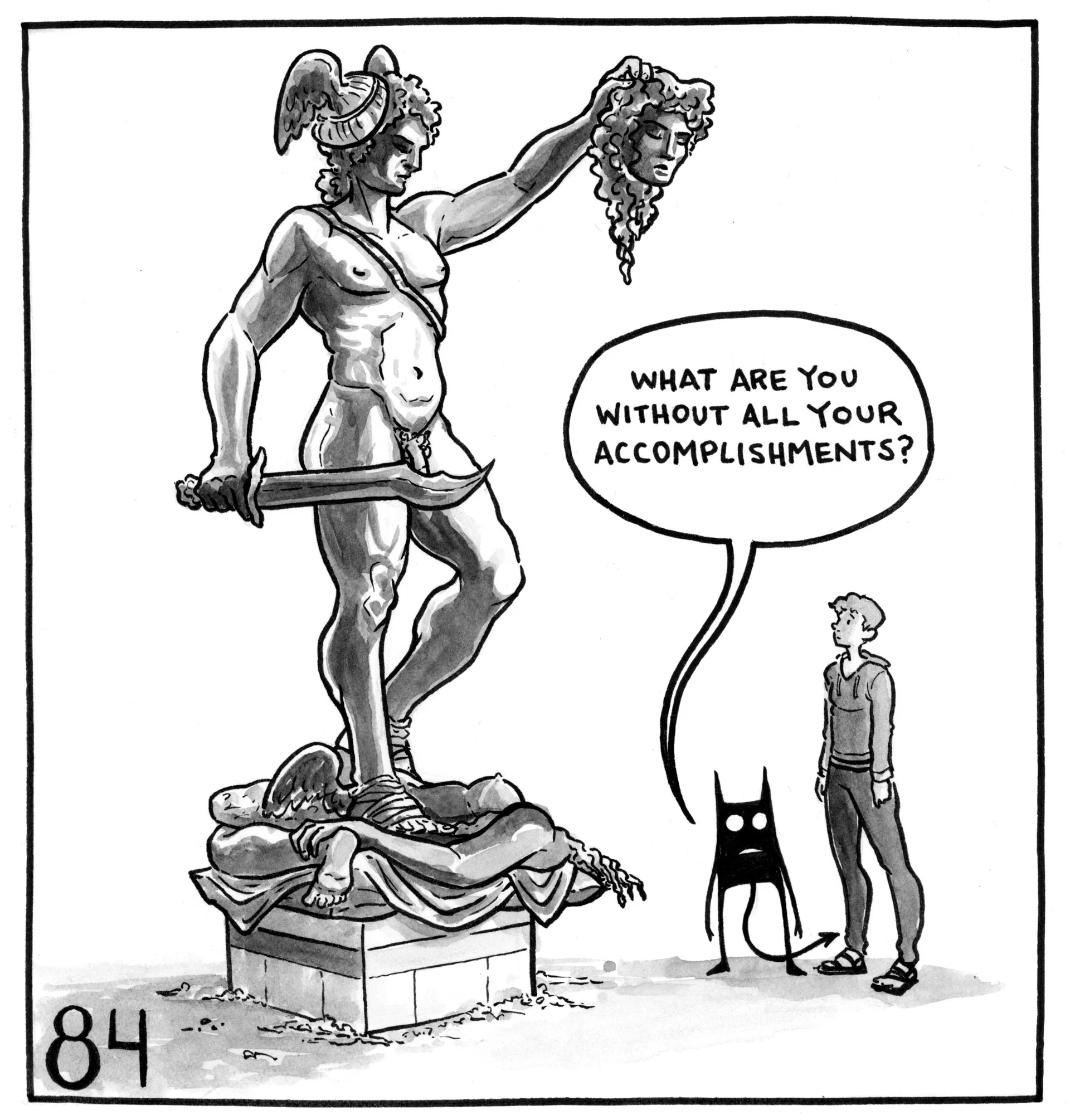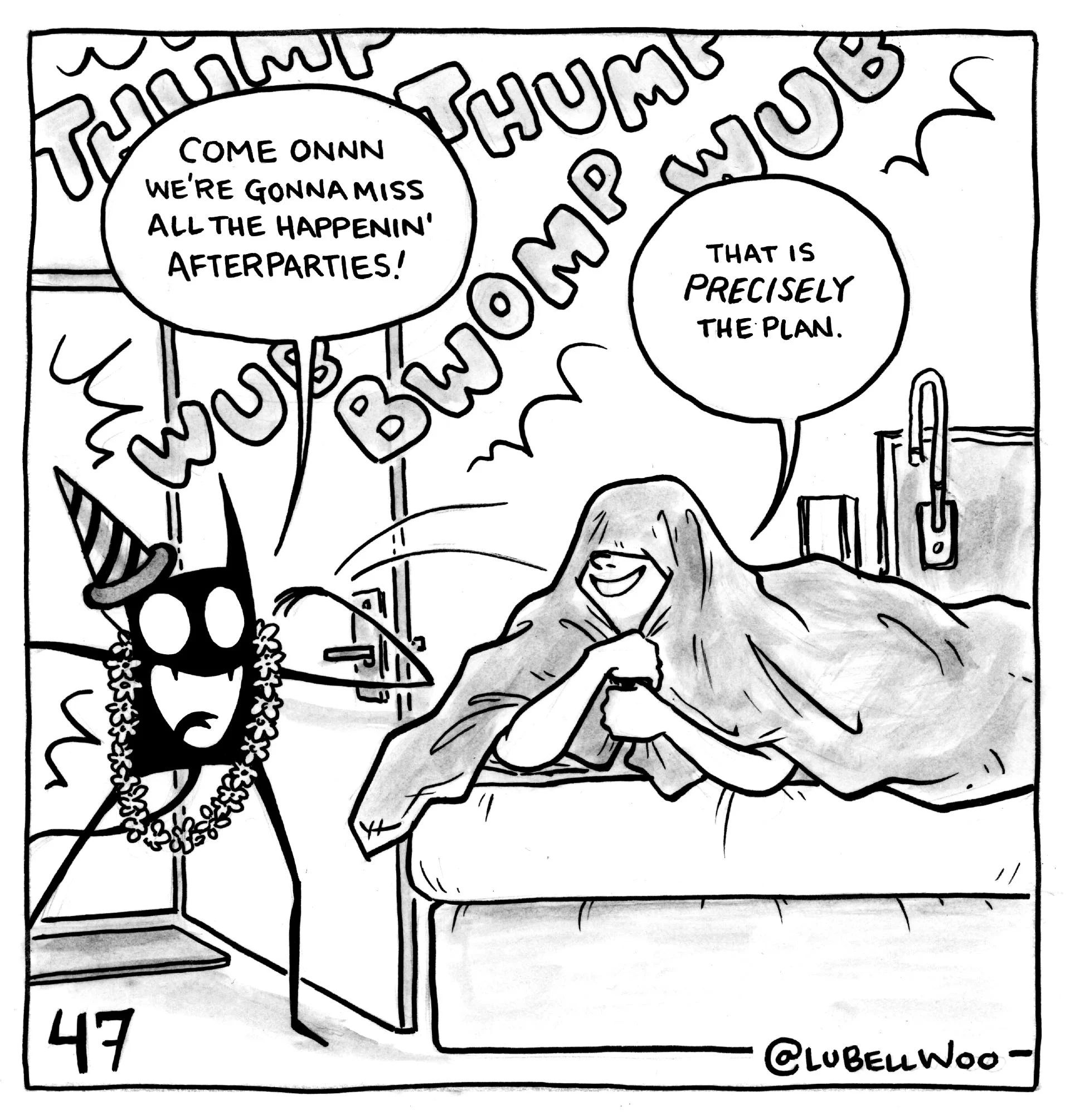

Think what your imagination could conjure if you sketched something every day for 100 days. For Lucy Bellwood, one of the artists who has contributed her work to our Paper Store, this creative structure birthed 100 Demon Dialogues: the hugely popular series in which she tackles her inner demons through cartoons.
In 2016 Lucy Bellwood embarked on a 100-day-long drawing project, an undertaking that is much harder than it sounds: 100 days is over three months. A quarter of an entire year. It’s an exercise in self-discipline and commitment, but such a commitment didn’t worry Lucy. She’s the kind of person for whom “embarking” upon something is second nature. A self-proclaimed “adventure cartoonist,” she has been known to break up her year by producing paintings, online comics, merchandise, sketches, drawings and graphic novels alongside books about her adventures, notably a 2016 Kickstarter-funded book Baggywrinkles, inspired by Lucy’s time spent aboard an 18th-Century tall ship sailing the high seas. As you do.
So for someone as proactive and curious as Lucy, a 100 day project just seemed like a good idea. It would act as a tool by which she could continually flex her drawing muscle, without the pressure of committing to something more full-on or long-term. “I really like structured drawing challenges, I think they do a lot to counteract my own perfectionism,” says Lucy from her home in Portland, OR. “I desperately believe in my heart of hearts that if I set out to do a full length book or a freelance project or 100 day project, somehow if I just work hard enough, I should be able to sit down with do it in a single continuous stretch of turbocharge labour.”

Her first go at it was A Life in Objects in which she illustrated an important object in her life every day for 100 days, accompanying it with a piece of text to explain what the object is and why it meant something to her (crucial for the anonymous reader, considering many of the objects she chose were otherwise rather unremarkable items such as old pairs of shoes or keyrings). This project became a collection of three books, which was then purchased by a lot of people who were drawn to the idea.
In 2017, after the success of the Objects books, Lucy was keen to get going on another 100 day project. This was when 100 Demon Dialogues was born. She was spurred on by Inktober, the month-long drawing trend artists join in on in a bid to get back to the drawing board (literally) and away from their computers to work on a fun, temporary project which they then share online with the hashtag #Inktober. “I feel like the practice of doing a daily project hammers into my brain that doing something small every day makes something big over time, which is super obvious,” she laughs. “I don't understand why I have to keep relearning this lesson over and over and over again.”



The first iteration of the demon character appeared in a notebook from back in 2012. It was only when the stress of coming up with an idea for Inktober and the growing pressure of the high quality of everyone else’s work came into play that Lucy decided to use this as an opportunity to actually illustrate her hangups. The project she began creating is “a collection of comics for anyone who deals with a little voice in their head that says ‘you’re no good.’” The comic sees Lucy create one-panel, black and white funnies depicting herself in different scenarios, always in the company of a small, black creature with pointed ears.
The creature, or “demon,” has the puff-of-smoke mobility of Casper the Friendly Ghost and the frenetic, irritating enthusiasm of the pesky devils in Disney’s Hercules. It is a visual representation of the negative voice in Lucy’s head. The voice we all have in us, the one that starts speaking loudly when you’re feeling low, or suffering with imposter syndrome, or worrying about something that hasn’t even happened yet. It’s the voice that won’t be silenced and sadly, for most of us, the voice that dominates. The voice can appear from nowhere, at any time, making it perfect for a one-drawing-a-day project. Whenever the demon materialized, Lucy would transform it into a cartoon. “The beauty of a daily practice project is that you have to choose something manageable enough that you can do it if you're on the road, if you're sick...it's just got to take an hour or less,” she explains. “It's got to be portable.”


I like structured drawing challenges. They counteract my own perfectionism.
Even the world’s most powerful people can find themselves waking up some days inexplicably plagued by some sort of annoying demon. People often describe their anxiety as a creature who, some days, is just there when they wake up. Maybe we don’t all see our own demons in the same aesthetic style as Lucy, but the frustrating conversations we have with them seem to be pretty universal. This became apparent to Lucy when she began publishing her one-a-day Demon Dialogue cartoons online and was bowled over by the response from her followers. “I would post an entry at night and go to bed and wake up to like, thousands of likes and tons of comments and all these people getting very excited about it,” Lucy recalls.
Confusingly, many of Lucy’s own demons were tied up in her conflicting attitude towards social media. On the one hand, the monotony and pressure of having to constantly promote your own work – something artists have a hard time escaping – was causing her demon-filled anxiety. On the other hand, the drawing of the demons and the sharing of them was garnering an enormous response from her followers. “I was feeling so frustrated that I had built up this audience and this expectation around how people were responding to the demon dialogues project,” she recalls. “I was drawing those demons to kind of exorcize some of my feelings of ‘you're not being viral enough!’ But it’s a double edged sword because I knew if I posted these demons, I would get a lot of comments and likes, which I did.”


The posts led to a demand for new drawings, which led to a book, then merchandise, and then finally to a tour. People who came to see Lucy often asked her if drawing the demons and visualising the conversations she had with her inner worries had been in some way therapeutic. “People did say to me, ‘Oh, so you're fixed now?’ And I don’t think that's really the point of the project,” says Lucy. “There's been a lot of other books published about imposter syndrome and the titles and taglines are always like: How to Banish Your Inner Critic for Good or Make Sure That You Never Have Another Negative Thought in Your Life! But that's just not what being human is.”
Lucy is happy to have used a visual representation of her own worries to help others. But more importantly, she’s pleased to have created such a multi-faceted, multi-platform project out of a simple drawing-a-day task. When she started, she didn’t know the effect it would have on anyone else’s life, let alone her own. She doesn’t believe she’s “cured” herself by characterizing the negative voices in her head, but it’s become useful as something to look at in retrospect. “When I look at the drawings, it's kind of magical. I think with a 100-day project, or any kind of drawing project, it sort of takes you back to wherever you were, like time travel,” she explains. “I can look at any one of those entries and remember, like, ‘Oh, I was in Boston! I was sick,’ or ‘I was feeling really anxious about X and sometimes those challenges have passed...I can look at it and say; ‘wow, do you remember all this trivial shit I was worrying about in 2017? That's just not a part of my life anymore. The stimulus for the drawing is not a part of my life anymore, but the feeling the drawings are expressing will probably be a part of my life for the rest of my life.”
Paper Store is a collection of creative prompts, daily exercises, and drawing tutorials. Turn "can't draw" into "can't stop.


